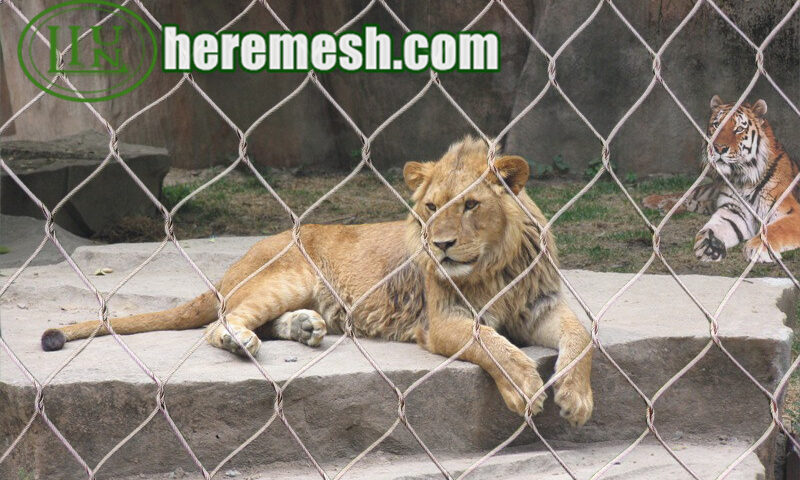Stainless Steel Cable Mesh: Redefining Safety and Ecology in Zoo Lion Enclosure

Bird Enclosure Project: Stainless Steel Cable Mesh Supply to UK
09/24/2025
Zoo Bird Habitat Solution: Bird Netting Fence Supply for France
10/11/2025In the operational framework of modern zoos, the design and construction of animal exhibits remain a critical challenge in balancing safety, animal welfare, and visitor experience. As apex predators, lion enclosures serve not only as the primary line of defense for visitor safety but also as essential spaces for showcasing their natural behaviors. The advent of stainless steel cable mesh has revolutionized the upgrading of lion enclosure. With its exceptional physical properties, eco-friendly characteristics, and visual transparency, it has redefined construction standards for large predator exhibits, becoming an indispensable core material in zoo planning.
Core Requirements for Lion Enclosures: Safety, Ecology, Experience
As large, powerful carnivores, lions require enclosure designs that address multiple needs. Based on zoo operational practices, a qualified lion enclosure must meet three core objectives: absolute safety barriers, a naturalistic ecological environment, and an immersive visitor viewing experience.
Safety: Primary Principle
A lion’s bite force can reach 375 kilograms, and it possesses exceptional climbing and jumping abilities. This means enclosure materials must exhibit ultra-high strength and impact resistance to withstand repeated collisions and bites from lions. The safety of enclosure materials is critical for both visitors and animals. For lion enclosures, absolute safety is non-negotiable; material strength and durability must undergo rigorous testing.
Ecology: Meeting the Natural Behaviors of Lions
Modern zoos have long moved beyond the traditional “cage-based”display model, instead pursuing the development of “ecological exhibits”. The core principle is allowing animals to exhibit natural behaviors within their enclosures, which is central to animal welfare. Traditional enclosures often disrupt this ecological simulation, leading to stereotypical behaviors. Improper mesh spacing and rigidity in standard wire fencing can injure lions’ skin and claws, while their lack of visual integration with natural environments detracts from the exhibit’s ecological aesthetics. Therefore, lion enclosures must be invisible while ensuring safety. They must maintain isolation functions without hindering natural animal behaviors or compromising the exhibit’s ecological integrity.
Experience: Immersive Tourist Viewing
The core desire of visitors to zoos is to observe animals in their natural state up close. An ideal lion enclosure should allow visitors to clearly see the lions’ natural behaviors from a safe distance, without their view being obstructed by thick materials. At the same time, the enclosure materials must also possess a certain aesthetic appeal, blending seamlessly with the surrounding vegetation to enhance the overall quality of the zoo.
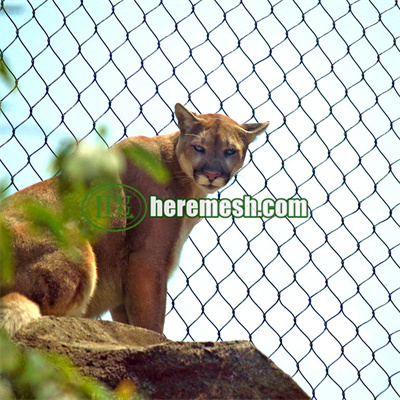
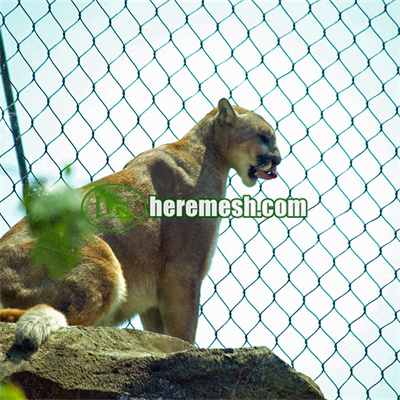
High-Performance Lion Enclosure Netting
Stainless steel cable mesh is not merely an upgrade of conventional metal mesh, but a material developed specifically for large predator exhibits. Crafted from 304 and 316 stainless steel through a specialized, entirely hand-woven process, it surpasses traditional enclosure materials in strength, durability, ecological compatibility, and visual appeal. This makes it the ideal solution for meeting the core requirements of lion enclosure.
Safety and Flexibility
The core advantage of stainless steel cable mesh lies in its exceptional physical strength, enabling it to directly withstand violent impacts and destructive attempts by lions. The netting can endure the full force of an adult male lion’s charge without breaking or deforming. Furthermore, the flexibility of stainless steel cable mesh is a key characteristic that distinguishes it from traditional rigid materials. When lions strike or bite the netting, the rope netting absorbs the impact through slight deformation. This not only reduces injury to the lions but also further enhances the netting’s resistance to damage. Rigid materials are prone to fatigue fractures under repeated impacts, whereas flexible stainless steel cable mesh releases stress through deformation, extending its service life.
Weather Resistance and Durability
Lion enclosures in zoos are predominantly outdoor environments. Prolonged exposure to outdoor conditions subjects them to erosion from various corrosive substances. Stainless steel rope netting significantly reduces maintenance costs due to its exceptional corrosion resistance. Grade 304 effectively blocks oxygen and moisture, while Grade 316 remains rust-free even in humid coastal regions over extended periods. Additionally, stainless steel lion enclosures exhibit outstanding UV resistance. When exposed to prolonged sunlight, the physical properties of stainless steel rope netting remain stable, with no reduction in strength due to sun exposure. This characteristic is especially crucial for zoos in tropical regions, ensuring the enclosures remain safe and reliable under high temperatures and intense sunlight.
Eco-Friendliness
The eco-friendly nature of stainless steel cable mesh stands as one of its core distinguishing features compared to traditional materials. Its high transparency and seamless integration with nature liberate lion enclosures from the constraints of cages, creating habitats that closely mimic the wild. From an ethological perspective, the mesh structure of stainless steel cable mesh does not obstruct lions’ line of sight or range of movement. Lions can observe the environment beyond the enclosure through the mesh, reducing stress reactions caused by monotonous surroundings.
In exhibit design, stainless steel cable mesh also integrates seamlessly with natural landscapes. Customizable in black, it blends harmoniously with vegetation within the enclosure, avoiding any jarring visual impact. Additionally, the smooth surface of the netting prevents skin abrasions in animals, demonstrating its positive contribution to animal welfare.
Visual Transparency
This transparency significantly enhances visitors’ viewing experience. The nearly invisible mesh allows visitors to intuitively sense the vitality of lions, deepening their awareness and concern for wildlife conservation. From an operational perspective, high-visibility enclosures also enhance exhibit interactivity. Zoos can host various events enabling visitors to observe animal behaviors up close while learning about conservation. This interactive model significantly boosts visitor engagement and satisfaction, elevating the zoo’s reputation.
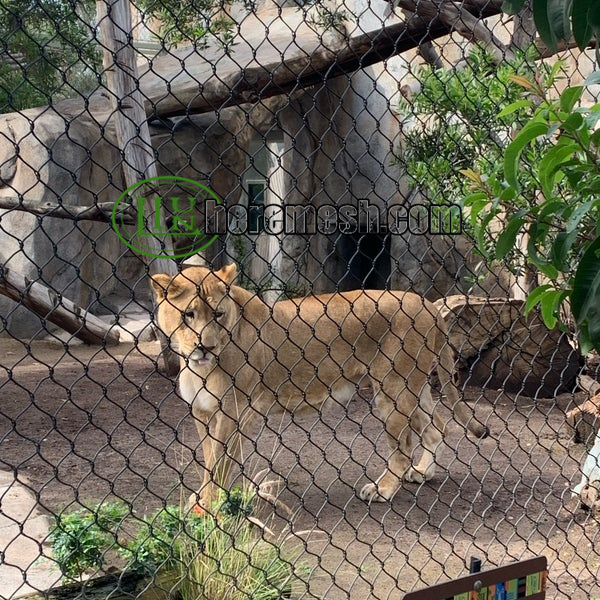
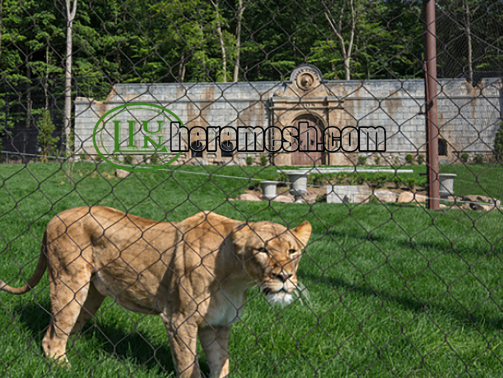
Practical Application of Cable Mesh in Lion Enclosure Construction
The application of stainless steel cable mesh in lion enclosure is not merely a simple material substitution. Lion enclosures require systematic design and construction that integrates the behavioral characteristics of lions with the topography of the exhibit area. From preliminary planning to final construction, every step demands strict oversight. Only through such meticulous control can the advantages of stainless steel cable mesh be fully realized, ensuring the enclosure’s safety, ecological integrity, and visitor experience value.
Determination of Cable Mesh Specifications
The core of enclosure design lies in determining the specifications of the wire mesh. Key parameters for stainless steel wire mesh are established based on the lions’ body size and behavioral habits, forming the foundation for ensuring safety and ecological requirements. Enclosure requirements vary across different age groups of lions. To prevent escapes, the wire diameter should be no less than 3.2mm, with mesh sizes controlled between 51mm and 100mm. A reasonable mesh size ensures safety while accommodating the lions’ activity needs. Excessively large mesh openings risk allowing cubs to squeeze through.
Material Selection
By material classification, stainless steel lion enclosures are primarily divided into 304 stainless steel cable mesh and 316 stainless steel cable mesh. 304 stainless steel rope netting is suitable for dry, low-rainfall inland regions and meets the requirements of most lion enclosures. 316 stainless steel rope netting is suitable for humid, rainy coastal areas, offering superior corrosion resistance and significantly extending service life.
By weaving technique, they are primarily categorized into ferrule mesh and woven mesh. Ferrule mesh uses stainless steel ferrules to connect wires into a mesh panel, offering easy installation and suitability for exhibits requiring future adjustments. Woven mesh employs an integrated weaving process, resulting in a more stable structure and superior impact resistance. It is ideal for high-strength applications like adult lion enclosures. In practical applications, a “hybrid” design can be adopted: the main enclosure uses woven mesh for strength, while the perimeter employs ferrule-type mesh for easier maintenance.
By surface treatment, options primarily include natural stainless steel rope netting and black oxidized stainless steel rope netting. The surface is smooth with a strong metallic sheen, offering an elegant and sophisticated appearance. Black oxidized rope netting blends better with natural environments and reduces glare, making it suitable for exhibits with high visual effect requirements.
Construction and Installation
The installation of stainless steel lion enclosure is a critical step in ensuring enclosure safety, where even minor oversights can lead to serious consequences. Construction must strictly adhere to specifications with meticulous attention to detail.
The enclosure foundation must utilize reinforced concrete to withstand the impact forces from both the rope netting and the lions. During foundation construction, installation holes for the rope netting fasteners must be pre-reserved to ensure even load distribution. When installing the rope netting, ensure it fits tightly against the frame. Finally, tension the netting using tensioners to adjust the tension to 20-30 KN, preventing sagging that could allow lions to escape or climb through.
Post-Construction Maintenance
Although stainless steel cable mesh is highly durable, regular maintenance is still required during long-term use to promptly identify and address potential issues, ensuring the enclosure remains in a safe condition at all times. When damage occurs to the rope netting, it must be addressed promptly according to the severity of the damage to prevent accidents such as animal escapes. Additionally, high-pressure water jets can be used to clean contaminants from the surface of the stainless steel rope netting. This process does not require cleaning agents, avoiding chemical damage to the netting.
Conclusion
In today’s era where animal welfare is prioritized and visitor experiences are constantly enhanced, stainless steel rope mesh has evolved beyond being a mere barrier material. It perfectly balances the three core requirements of lion enclosures, establishing itself as a vital architectural component. Stainless steel rope mesh will further expand its application boundaries, providing solutions for exhibits housing other large predators such as tigers and leopards. If you require animal enclosures, Liulin Zoo Mesh Factory can offer customized production. We welcome you to contact us.


